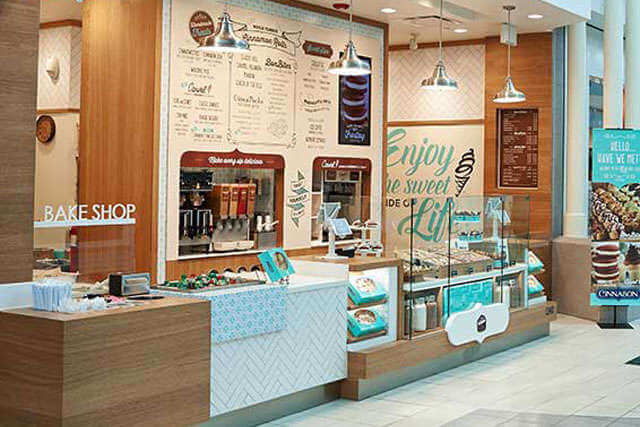By Michael Seid, Managing Director, MSA Worldwide
Until recent times, franchising was considered a non-traditional method of distribution. Today, with the recognition that has been achieved for the delivery of consistent, quality products and services through stable, recognized brand names, the opportunities to penetrate new markets have begun to multiply rapidly. This includes through non-traditional franchisees and locations.
There are a host of what can be called non-traditional franchisees and locations, including international franchisees, multi-unit investor groups, core vs. tertiary markets, and tandem franchise relationships. This article addresses those opportunities in locations which provide franchisors with a captured audience – the mass gathering locations.
Mass Gathering Opportunities
Mass gathering locations are those sites which attract a large audience and provide retailers with a captive clientele for a defined period of time.
Traditionally, these have included stadiums, arenas, ballparks, university and college cafeterias, convention centers, state and national parks, theme parks, military bases, office and industrial complexes, and even hospitals.
In addition, we are seeing an increasing penetration by franchisors into other retailing establishments where the large customer base of the host retailer is introduced to the franchised operation. Using recognized brand name franchisors, the retailer is providing additional customer services to their customers. However, the real purpose is to provide the customer with a reason to remain longer within the location and increase their per-visit purchases.
The predominant segment of franchising most affected by these opportunities will be food. Other retail and service segments, including hair care, eyeglasses, property management, and maintenance among others will also benefit from these opportunities.
The mid 1980s began a major transformation in the types of food available in the nation’s mass gathering locations. In the past, travelers at airports and highway rest stops complained of overpriced and poor quality food from unknown suppliers. Today, the major concession companies, which hold the rights to supply food and services at these types of locations, have adopted a national and recognized local brand name philosophy within their food service facilities.
Back in 1986 I recall that McDonald’s opened a restaurant in the Minneapolis-St. Paul International Airport near one of Marriott’s generic restaurant operations. Marriott was convinced at the time that it could compete with its generic branded outlet against McDonald’s, and placed signs in their window proclaiming that their one-third pound hamburger cost less than McDonald’s quarter pounder.
Unfortunately, the public did not agree and opted for the brand recognition of the known supplier. Five years later, Marriott converted its restaurant to a Burger King franchise. According to Robert Dorfman, Executive Vice President of Marriott’s Host International Division which operated the concessions at Minneapolis – St. Paul, “We lost our shirt. We couldn’t do anything that would convince people that our burgers were better than McDonald’s. It was just a pure confidence issue.”
Marriott is one of many large and small companies that have purchased the rights to operate the concessions within the mass gathering operations. Other companies include ARA, Delaware North (Concessionaire and Sports Services), Spectacor, Fine Host, and Dobbs, to name just a few. Where traditionally these companies have developed and operated their own “no name concepts,” today they have all, to some degree, embraced a branded program within the facilities they manage.
Marriott began developing branded food courts in 1983 at its rest areas on state toll roads by combining Roy Rogers with Bob’s Big Boys. Sales increased by between 200 and 300 percent at these locations following the conversion. Since that time, Marriott has introduced other nationally recognized companies at their roadside facilities, including Pizza Hut, Burger King, Nathan’s, Mrs. Field’s Cookies, Vie de France, Dunkin Donuts, and TCBY.
When Marriott won the concession rights to Boston’s Logan Airport they included in their RFP to the Massachusetts Port Authority well-known local and national suppliers. These names included Legal Seafood, Burger King, Mrs. Field’s Cookies, TCBY, Balducci’s Pizza, Coffee Connection, Sam Adams Pubs, Finagle-a-Bagle, and Taste of Boston Deli.
To acquire the right to operate the Logan Airport facilities, Marriott reportedly has committed almost $5 million dollars in capital to renovate the terminals. The Massachusetts Port Authority expects to earn approximately $800,000 per year from the Marriott operations.
The cost for a concession firm to acquire the rights to operate the food service and other operations at mass gathering facilities can be extremely high and can exceed an eight-figure commitment. The high investment commitment isn’t any different for the franchisor.
Marriott has also introduced other recognized retailers into their airport locations, including Bloomingdales, which opened a Bloomies Express at BWI airport, a Cheers Bar based on the popular TV show where they also sell theme merchandise in the Detroit and Minneapolis airports, and Cockpit, a retail outlet for an aviation theme catalog sales company.
Food services in stadiums, arenas, and ballparks have not been left out of the move toward increased brand recognition and variety.
Since the opening of the 1991 baseball and football seasons, fans of the Seattle Mariners and Seahawks have had alternatives to traditional stadium fare from recognized national brand names including Pizza Hut, Starbuck’s, and TCBY, as well as local favorites including Skipper’s seafood and Ezell’s chicken. In some ballparks, fans can purchase vegetarian foods, health food, and even sushi.
Following the introduction of branded products at the King Dome, Ogden Allied announced that revenues increased by over thirty percent over the preceding year. Sales increased by four hundred percent when they introduced Old El Paso Nacho carts to replace their generic product. Hot dogs continue to be the traditional fan favorite, but name brands have begun to replace the “mystery meat” of the past.
Unfortunately, for many of the franchisees operating in the King Dome, the sole benefit they receive from being in the stadium is increased recognition. Ogden charges a fee reported to be as high as $100,000 per cart, together with a negotiated premium of six to ten percent of total sales. Therefore, few vendors are expected to make money from the locations.
However, the marketing benefit of being in the stadium has reportedly increased customer traffic in the vendors’ outside locations.
Many other stadiums are now offering alternatives to “baseball dogs.” For example: Carls Juniors, Taco Bell, Pizza Hut and TCBY are in Dodger Stadium; Jack Murphy Stadium in San Diego and Tiger Stadium in Detroit sell Domino’s Pizza; Subway sandwiches and Round Table Pizza are sold at the Oakland Coliseum; McDonald’s and Hard Rock Cafe are in Toronto’s Sky Dome; and Pizza Hut is in the Seattle Super Dome. By the end of the decade, according to Restaurants and Institution Magazine, “most food sold at almost every major stadium will come directly from kitchens of familiar fast food chains.”
The entrance into mass gathering locations is not without a certain degree of risk for franchisors, both financially as well as qualitatively.
Because the cost of development and operations in the mass gathering facilities is high, the prices charged to customers tend to be higher. Customers who are used to paying lower prices at the local franchises may resent paying higher prices at the stadiums where they have no alternatives.
This perception of price gouging is so pronounced that the owners of some sports teams require the concessionaire to maintain unrealistically low prices on certain items, which then makes the locations unprofitable.
In addition to the cost of development and operations, advertising contributions are often also required of the franchisor, and these contributions can be significant. In some instances, a requirement for obtaining the right to sell products at a theme park included the building or sponsoring of an attraction.
Sales at ballparks are naturally tied to attendance, the type of sport being played, and the season in which the sport is played.
Football fans in 1990 spent on average $8.00 on food in the stadium, while baseball fans only spend $6.75 per game, primarily because half time provides a greater opportunity to make purchases than the few minutes between innings. Because there are far fewer games in football than in baseball, total revenue per fan over the season is lower in football than in baseball and naturally, ice cream sells better in baseball stadiums because of the season of play, while coffee and hot drinks sell better at football stadiums.
But in any sport, when the home team is not performing well, attendance declines and sales at the league’s doormat teams naturally do not meet those of league contenders.
Sales within airports are also subject to variation. When airlines reroute, discontinue, or decrease their service to hubs, traffic and therefore customers decline. And, for those operations which rely upon sit-down service, the limited time between connecting flights of 30 minutes or less limits the number of customers to those whose flights originate from the airport.
There is also a dramatic difference in the amount spent by passengers from airport to airport. In 1992, the average spent by passengers at Atlanta’s Hartfield Airport was only $3.53, while at Portland Oregon’s International Airport passengers spent approximately $7.00 per person.
Qualitatively, operations in some mass gathering locations are extremely problematic. Operations in stadiums, arenas, ballparks, convention centers, and other locations not consistently open are often plagued with problems arising from the fact that the employees at these locations are part-time and untrained, with a significantly higher turnover rate than at locations open year-round. Therefore, the absence of quality and consistency which initially attracts customers to the nationally recognized brands can cause damage to the traditional locations.
I recently spoke with a major franchisor of frozen treats that had pulled out of several profitable ballparks. While they had trained the concession company’s management on the product, the lack of sanitary conditions caused by the poorly trained transient staff’s inability to clean and sanitize the soft serve machines, in the opinion of the franchisor, had placed the public health at risk. In addition, the poor quality of the service provided to the customers was inconsistent with their general franchised and company-owned operations, and there was a real threat to the public’s perception of all of the franchised locations.
For example, Fine Host, which is the concession holder for the Columbus Convention Center, estimates that it will have only 15 full-time employees at the convention center. The other 90 staff required to operate the convention center’s concessions will all be part-time workers. At some facilities, the concession holder will contract with charitable organizations who supply part-time staff to operate the food facilities as a fundraising program for their organizations.
Many franchisors cannot penetrate directly into the mass gathering locations anyway, as the concession rights have been purchased by the major concessionaires, or the franchisor has not achieved any significant trade name status. In addition, in municipally owned facilities, the RFP process is very strenuous and often requires minority or small business set-asides.
The City of Denver, for the new Denver International Airport, has developed a training program called “The Ready Take Off Program” to train women and minorities on how to submit bids for the set-aside locations. I believe this training program is the only program of its type in the country. Should any of the independents succeed in winning the right to operate in the terminals, they will need to be prepared to pay rent of approximately $175 per foot plus the cost of construction on very stringent and expensive guidelines, which may make the victory a dubious and risky success.
Rent and financial arrangements vary among airports. For example, at Nashville’s Airport, rent is approximately $36 per square foot, with the airport charging in addition between 18 to 26 percent of gross receipts.
Alternative Markets
Often, when exploring alternative methods to distribute their products, franchisors must re-think their traditional methods of delivery. All of us are familiar with the self-service Dunkin Donut locations in convenience stores and service stations. Those of us on the east coast are beginning to see Carvel Ice Cream Bakeries in supermarkets, and companies like Home Depot, Wal-Mart, and KMart are now offering food and other services to their customers through franchised operations.
While it has been fairly common for franchisors to operate in tandem with other non-competing operators, as in the Reese Brothers operations in New York, the announcement of the sale of Freshen’s yogurt through Diet Center, or the sale of I Can’t Believe It’s Yogurt through non-franchised independent restaurants in conjunction with their franchisees, or their distribution of yogurt on American Airlines, are more unique.
Several of the concession companies, including the major concessionaires mentioned above, have operations in educational, hospital, and corporate cafeterias. Two companies with a primary focus in this area are Daka International, which acquired Service America’s education food service operation in August, and Silers. Both companies have also moved to nationally recognized branded products.
Operations at these types of food service locations differ from stadiums, arenas, ballparks, and concessions in that the facilities are operated throughout the year, but are similar in that they serve a more captive audience.
At the BSU Student Union operated by Marriott, the traditional cafeteria has been replaced by two food courts, Maggies Food Court and Brava, which will serve food from The Grill, SubCity, Pizza Hut, Taco Bell, KFC, LaVincitia (a pasta and sandwich shop), TCBY, and White Mountain Coffee. Marriott will feed over 18,000 student meals per week at Boise State.
Given the budget restraints at many universities, and their historic reputation for poor quality food, the use of branded outside service and product suppliers is becoming common. This is also true at military bases and their PXs and commissaries.
In addition to food service operations, many concession operators are also providing other services to these locations, including facility maintenance and daycare.
Some Practical Restraints
Attorneys have commented to me that in some instances, case law and proposed legislation may limit a franchisor’s ability to enter into alternative locations. These include both the mass gathering locations which are in close proximity to existing franchisees or in their exclusive territory, and in alternative distribution sites including convenience and grocery stores.
If you have listened to the testimony of some franchisees at state and federal hearings, the definition of close proximity in their eyes may be quite a bit different than as understood by the franchisor.
In addition, many of the existing franchise agreements do not provide the franchisors with the ability to enter into alternative methods of distribution or alternative mass gathering sites, because the agreements do not provide for carve-outs to the exclusive territories for these types of operations.
In those instances where the franchisor has not provided themselves with these rights, the franchisors are faced with negotiating back these rights from their franchisees (which may include allowing their participation in the transactions) or forgoing the opportunity entirely. In some cases, where the franchisee is willing and financially able to open in mass gathering locations, the concession holder may desire to become the franchisee for their own operations. As they have developed an infrastructure to operate their own generic locations in the past, they have the ability to operate efficiently and effectively the franchised operations directly.
When selecting franchisors, some of the concessionaires desire to enter into many locations with the same franchisor in order to limit the number of relationships they have with “suppliers.” The elimination of key locations because the franchisor lacks the rights in those markets due to a franchisee’s protected territory may cause the franchisor to lose the multi-location opportunity. The support of the franchisees is therefore important for successful entrance.
The same holds true for franchisors who wish to enter into alternative distribution systems, such as pre-packaged products in supermarkets, under the franchisor’s recognized mark.
It is important, therefore, that franchisors review with their franchise counsel future plans for alternative expansion in order to make the necessary revisions to the disclosure document and franchise agreements.
Do you have further questions about recruiting non-traditional franchisees?
MSA can provide expert guidance on attracting qualified franchise candidates for a successful and sustainable franchise business.




